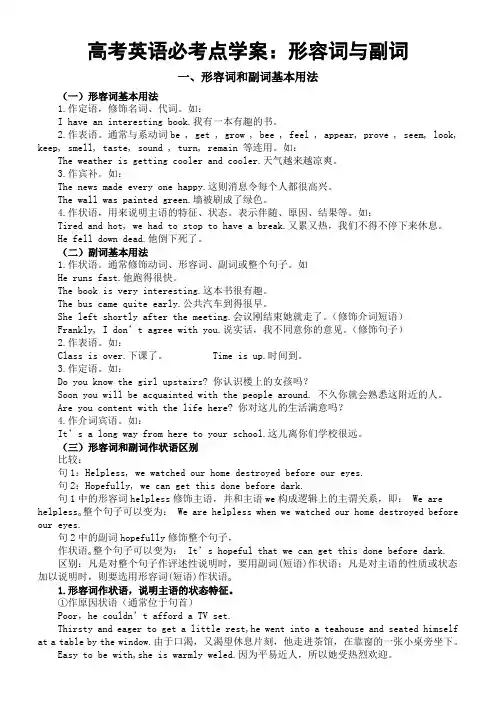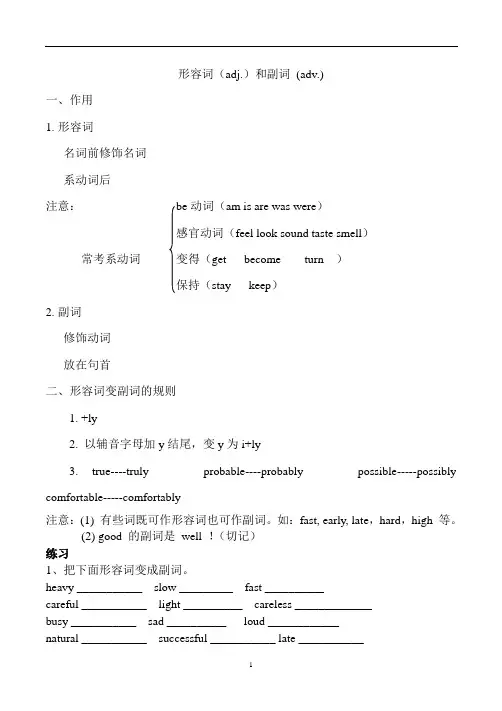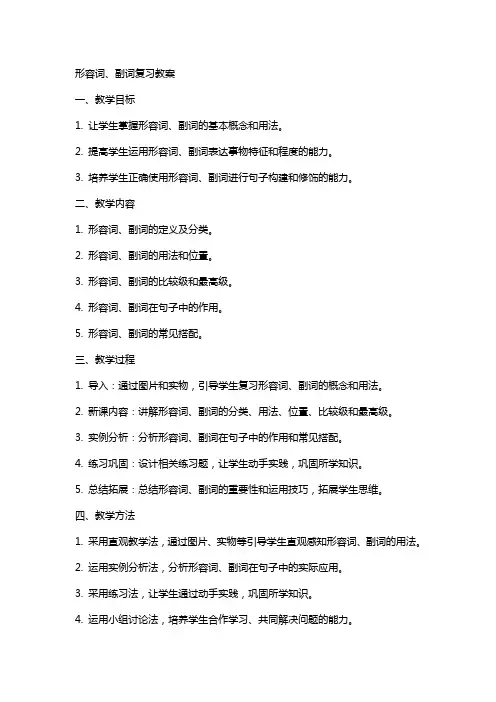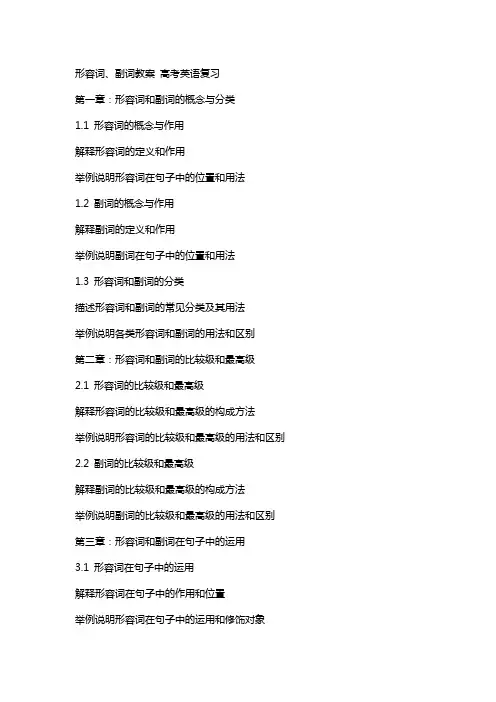高三语法复习-形容词副词用法复习课
- 格式:ppt
- 大小:210.00 KB
- 文档页数:10


高考英语必考点学案:形容词与副词一、形容词和副词基本用法(一)形容词基本用法1.作定语,修饰名词、代词。
如:I have an interesting book.我有一本有趣的书。
2.作表语。
通常与系动词be , get , grow , bee , feel , appear, prove , seem, look, keep, smell, taste, sound , turn, remain 等连用。
如:The weather is getting cooler and cooler.天气越来越凉爽。
3.作宾补。
如:The news made every one happy.这则消息令每个人都很高兴。
The wall was painted green.墙被刷成了绿色。
4.作状语,用来说明主语的特征、状态。
表示伴随、原因、结果等。
如:Tired and hot, we had to stop to have a break.又累又热,我们不得不停下来休息。
He fell down dead.他倒下死了。
(二)副词基本用法1.作状语。
通常修饰动词、形容词、副词或整个句子。
如He runs fast.他跑得很快。
The book is very interesting.这本书很有趣。
The bus came quite early.公共汽车到得很早。
She left shortly after the meeting.会议刚结束她就走了。
(修饰介词短语)Frankly, I don’t agree with you.说实话,我不同意你的意见。
(修饰句子)2.作表语。
如:Class is over.下课了。
Time is up.时间到。
3.作定语。
如:Do you know the girl upstairs? 你认识楼上的女孩吗?Soon you will be acquainted with the people around. 不久你就会熟悉这附近的人。

高中英语语法复习天津市汉沽区第五中学刘华(一) 形容词、副词的作用与位置1. 形容词是用来修饰名词的,常被放在名词前作定语或放在系动词后面作表语。
He is a young man.He is young.2.副词则用来修饰形容词、动词、其他副词或者句子,一般位于形容词之前,动词之后或句子之首。
It’s very good.He runs fast.I’m very well.He has not been to Japan recently.以下属几种特殊情况,须牢记:1.形容词短语作定语,定语后置。
a language difficult to mastera leaning tower about 180 feet high2. 表语形容词(afraid , alike , alone , asleep, awake , alive 等)作定语,定语后置如a man alive有些表身体健康状况的形容词如well , faint ,ill 只作表语。
sick既可作表语又可作定语,ill 如作定语意为“bad” 。
3. 形容词用作定语,修饰不定代词通常后置。
Something important4. else 常用作疑问代词和不定代词的后置定语。
What else, somebody else.5. enough 修饰名词前置.I have enough money to buy this book .但enough 修饰形容词、副词时必须后置。
He runs fast enough.This book is good enough.6. 几个副词并列作状语时,其顺序较灵活,一般是:方式-地点-时间。
We had a good time together outdoors last Sunday.7. 频度副词often , always , usually 等放在be 之后、行为动词前。
He is always working hard.8. 副词作定语,定语后置。



高中英语形容词副词用法详解形容词、副词用法详解形容词形容词是描述人或物的性质、状态或特征的词。
Ⅰ形容词的分类:1. 简单形容词:kind 善良的 green 绿色的 bright 聪明的 broad 宽广的 interesting 有趣的注意:1)形容词具有独特的后缀形式名词/动词+ ful:careful 细心的 thankful 感激的名词/动词+ less:homeless 无家可归的careless 粗心的名词+ ly:friendly 友好的 lovely 可爱的名词+ ous:dangerous 危险的 poisonous 有毒的2)以-ly 结尾的貌似副词的形容词friendly 友好的 silly 愚蠢的,糊涂的lovely 可爱的 lively 精力充沛的elderly 年长的,过时的 deadly 致命的,死一般的brotherly 兄弟般的 manly 有男子气概的motherly 慈母般的2. 复合形容词:复合形容词是由两个或两个以上的单词通过连字符的连接而合成的起到形容词作用的词。
1) 数词+名词a ten-speed bicycle 十速自行车1,000-metre race 1,000米赛跑2)数词+名词eda three-footed table= a three-legged table三条腿的桌子four-eyed fish四眼鱼3)数词+名词+形容词a five-year-old boy 五岁的男孩an 800-metre-long bridge 一座八百米长的桥4)名词+形容词a world-famous expert 世界著名的专家duty-free product 免税产品5)名词+现在分词peace-loving people 热爱和平的人们an English-speaking country 说英语的国家6)名词+过去分词a man-made lake 一个人工湖a snow-covered mountain 一座被雪覆盖的山7)形容词+名词new-world 新大陆的the Mid-autumn Festival 中秋节8)形容词+现在分词an easy-going classmate 易相处的同学a long-standing friendship 长久的友谊9)形容词+过去分词a new-found house 新近找到的房子ready-made clothes 现成的衣服10)形容词+名词edan absent-minded child 一个心不在焉的孩子a warm-hearted girl 一个热心肠的女孩11)副词+现在分词far-reaching significance 深远的意义a hard-working mother 勤劳的母亲12)副词+过去分词a well-educated gentleman 受过良好教育的绅士a newly-built library 一个刚建的图书馆注意:当复合形容词中含有可数名词时,这个名词只能用单数。

形容词(adj.)和副词(adv.)一、作用1.形容词名词前修饰名词系动词后注意:be动词(am is are was were)感官动词(feel look sound taste smell)常考系动词变得(get become turn )保持(stay keep)2.副词修饰动词放在句首二、形容词变副词的规则1. +ly2. 以辅音字母加y结尾,变y为i+ly3. true----truly probable----probably possible-----possibly comfortable-----comfortably注意:(1) 有些词既可作形容词也可作副词。
如:fast, early, late,hard,high 等。
(2)good 的副词是well !(切记)练习1、把下面形容词变成副词。
heavy ___________ slow _________ fast __________careful ___________ light __________ careless _____________busy ___________ sad __________ loud ____________natural ___________ successful ___________ late ___________good ___________ lucky ___________ early __________二、选词填空。
1,He is a ________ student, and he always does _______ at school. ( good / well ) 2. My father usually finishes his jobs ______________. He is a __________ man. ( successful / successfully)3. I am so ________ today. I won the match __________. ( lucky / luckily)4. Shanghai is a ________ city. Everyone works _________. (busy / busily )5. She sings really __________. ( good / well )6. Don’t drive too __________ ( fast ). It’s dangerous.7. Tim goes to school _________ every day. But it’s too ________ today. ( early)8. I am never _________ for school. But today I got to school too _________. ( late )9. Listen to teachers __________ in class. You should be __________.( careful / carefully)10, Tony is a __________ boy. He lost his bag ___________ this morning. ( careless / carelessly)三、用括号里所给词的正确行使填空。


形容词、副词复习教案一、教学目标1. 让学生掌握形容词、副词的基本概念和用法。
2. 提高学生运用形容词、副词表达事物特征和程度的能力。
3. 培养学生正确使用形容词、副词进行句子构建和修饰的能力。
二、教学内容1. 形容词、副词的定义及分类。
2. 形容词、副词的用法和位置。
3. 形容词、副词的比较级和最高级。
4. 形容词、副词在句子中的作用。
5. 形容词、副词的常见搭配。
三、教学过程1. 导入:通过图片和实物,引导学生复习形容词、副词的概念和用法。
2. 新课内容:讲解形容词、副词的分类、用法、位置、比较级和最高级。
3. 实例分析:分析形容词、副词在句子中的作用和常见搭配。
4. 练习巩固:设计相关练习题,让学生动手实践,巩固所学知识。
5. 总结拓展:总结形容词、副词的重要性和运用技巧,拓展学生思维。
四、教学方法1. 采用直观教学法,通过图片、实物等引导学生直观感知形容词、副词的用法。
2. 运用实例分析法,分析形容词、副词在句子中的实际应用。
3. 采用练习法,让学生通过动手实践,巩固所学知识。
4. 运用小组讨论法,培养学生合作学习、共同解决问题的能力。
五、教学评价1. 课堂参与度:观察学生在课堂上的参与程度,了解学生对知识的掌握情况。
2. 练习完成情况:检查学生练习题的完成情况,评估学生的学习效果。
3. 小组讨论:评价学生在小组讨论中的表现,考察学生的合作能力和思维拓展程度。
4. 课后作业:布置相关作业,要求学生在课后巩固所学知识,提高运用能力。
六、教学资源1. 图片和实物:用于直观展示形容词、副词的描述对象。
2. 练习题:设计不同难度的练习题,巩固所学知识。
3. 小组讨论材料:提供相关话题,促进学生互动交流。
4. 教学课件:制作课件,辅助讲解和展示知识点。
5. 课后作业:布置相关作业,让学生巩固所学知识。
七、教学步骤1. 导入:通过图片和实物,引导学生复习形容词、副词的概念和用法。
2. 新课内容:讲解形容词、副词的分类、用法、位置、比较级和最高级。


形容词、副词教案高考英语复习第一章:形容词和副词的概念与分类1.1 形容词的概念与作用解释形容词的定义和作用举例说明形容词在句子中的位置和用法1.2 副词的概念与作用解释副词的定义和作用举例说明副词在句子中的位置和用法1.3 形容词和副词的分类描述形容词和副词的常见分类及其用法举例说明各类形容词和副词的用法和区别第二章:形容词和副词的比较级和最高级2.1 形容词的比较级和最高级解释形容词的比较级和最高级的构成方法举例说明形容词的比较级和最高级的用法和区别2.2 副词的比较级和最高级解释副词的比较级和最高级的构成方法举例说明副词的比较级和最高级的用法和区别第三章:形容词和副词在句子中的运用3.1 形容词在句子中的运用解释形容词在句子中的作用和位置举例说明形容词在句子中的运用和修饰对象3.2 副词在句子中的运用解释副词在句子中的作用和位置举例说明副词在句子中的运用和修饰对象第四章:形容词和副词的搭配和固定短语4.1 形容词的搭配和固定短语解释形容词的常见搭配和固定短语的用法举例说明形容词的搭配和固定短语在句子中的运用4.2 副词的搭配和固定短语解释副词的常见搭配和固定短语的用法举例说明副词的搭配和固定短语在句子中的运用第五章:形容词和副词的翻译和练习5.1 形容词和副词的翻译技巧解释形容词和副词翻译时需要注意的要点举例说明形容词和副词的翻译技巧和应用5.2 形容词和副词的练习题提供形容词和副词的练习题,包括选择题、填空题和改错题分析练习题的答案和解题思路,帮助学生巩固所学知识第六章:形容词和副词的辨析与运用6.1 形容词和副词的辨析解释如何根据语境和词义辨析使用形容词和副词举例说明形容词和副词在不同语境中的区别和正确运用6.2 形容词和副词在特定句型中的运用解释形容词和副词在定语从句、表语从句、宾语从句等特定句型中的运用方法举例说明形容词和副词在不同句型中的用法和注意事项第七章:形容词和副词的语法功能7.1 形容词的语法功能解释形容词在句子中的语法功能,如作定语、表语、宾语补足语等举例说明形容词在不同语法功能中的用法和注意事项7.2 副词的语法功能解释副词在句子中的语法功能,如作状语、修饰动词、形容词等举例说明副词在不同语法功能中的用法和注意事项第八章:形容词和副词的语态和时态8.1 形容词和副词的语态解释形容词和副词在不同语态(主动语态、被动语态)中的用法举例说明形容词和副词在不同语态中的表达和注意事项8.2 形容词和副词的时态解释形容词和副词在不态(一般现在时、一般过去时、一般将来时)中的用法举例说明形容词和副词在不态中的表达和注意事项第九章:形容词和副词的应试策略9.1 形容词和副词的考试题型分析分析高考英语中形容词和副词的常见题型,如选择题、填空题、改错题等举例说明各类题型的解题方法和技巧9.2 形容词和副词的应试策略给出形容词和副词的应试策略,如词汇积累、语法掌握、语境分析等举例说明应试策略在实际考试中的应用和效果第十章:形容词和副词的综合练习与提高10.1 形容词和副词的综合练习题提供形容词和副词的综合练习题,包括选择题、填空题、改错题和翻译题分析练习题的答案和解题思路,帮助学生巩固所学知识10.2 形容词和副词的提高建议给出形容词和副词的提高建议,如词汇拓展、语法复习、语境训练等举例说明提高建议在实际学习中的应用和效果重点和难点解析六、形容词和副词的辨析与运用形容词和副词的辨析:学生需要理解在不同语境中如何正确选择使用形容词和副词。
形容词和副词专项复习教案姓名冉智慧年级应用部2年级计划课时数6节课题英语语法复习专项----形容词和副词教学目标1、形容词的概念和基本用法2、副词的概念和基本用法3、形容词和副词的比较级和最高级的基本构成4、形容词和副词的比较级和最高级的基本用法和部分特殊用法难点重点1、形容词和副词的基本用法区别2、形容词和副词的比较级和最高级的形式任教班级课堂教学内容课前检查作业完成情况:优□良□中□差□建议__________________________________________过程英语语法形容词和副词知识梳理:提纲挈领,抓住重点和难点!一、形容词用来修饰名词,表示人或事物的性质、状态和特征的词,叫形容词。
形容词的作用,见下表:作用例句定语You can see a lot of beautiful flowers in the garden.表语Your coat is too small.宾语补足语The old woman keeps everything clean and tidy.注意:有些形容词只能作表语,如:alone, afraid, asleep 等。
例如:Don't wake the sleeping baby up. He is asleep.The old man is alone.形容词用来修饰something, anything, nothing, everything等不定代词,要放在这些词的后面。
例如:You'd better tell us something interesting.The police found nothing strange in the room.多个形容词做定语时排列的先后顺序是:1)冠词或人称代词 2)数词 3)性质 4)大小 5)形状6)表示老少,新旧 7)颜色 8)事务、质地、人的国籍、用途。
例如:His grandpa still lives in this small short house.他爷爷还住在这个矮小的房子里。
高考英语语法复习
形容词与副词知识讲解
一、形容词的用法
被形容词修饰的名词若还有其他词修饰,如冠词、指示代词、形容词性物主代词等,这些词要置于形容词前。
名词前的多个修饰语可用
“限定描绘大长高,
形状年龄和新老,
颜色国籍出材料,
作用类别往后靠”
来记忆。
二、易用错的几类形容词
三、形容词的比较等级
English is as interesting a subject as Chinese.
Which is the better of the two watches?
She is the taller of the two girls.
other或else把主语排除在比较对象之外;但如果不在同一范围比较则不需要用。
Susan is taller than any girl in her sister’s class.
四、副词的句法功能
五、副词的位置
六、副词比较等级的用法。
语法专题复习:形容词、副词教案课型:复习课教学目的:通过“精讲精炼,点拨疑难”的教学方法来复习和巩固形容词、副词的原级、比较级、最高级等的基本用法,练习和巩固含有形容词、副词的常用句式以及复习一些特殊的形容词和副词的用法,使学生了解高考试题对该部分的考查方法和设题规律。
力求使学生在复习和巩固的基础知识的同时,提高学生的语言运用能力和应试技巧。
教学思路:教学原则是“精讲精炼,点拨疑难”。
通过让学生做练习,达到复习和巩固知识的目的。
老师在提问学生和解答学生疑难的过程中,为学生指点迷津,梳理知识,扩展知识,提升应试能力。
教学方式:使用多媒体课件辅助教学。
基本使用全英授课,必要时,使用汉语解释。
教学过程:一、通过做练习复习关于形容词、副词的一些基础知识;二、分析高考试题对形容词、副词的考查方法,让学生熟悉该考点,了解高考试题的特点和命题规律。
通过纠正学生的错误,扩展和提升学生的已有知识,归纳解题的技巧,使学生达到触类旁通的目的。
三、给学生提出关于形容词、副词的备考建议。
以下是教学环节的具体设计:Teaching plan for Grammar Revision:Adjectives and AdverbsStep 1 Leading inPlay the video of Sunshine on my shoulders to arouse the students’ interest.Do you like the song? Yes. And so do I. Not only do I like the tune, but also the lyric. Let’s read part of the words together:Sunshine on my shoulders makes me happySunshine in my eyes can make me crySunshine on the water looks so lovelySunshine almost always makes me highWho can say something about the song or the singer?The song was sung by John Denver, An American country music singer. Though it is very old, it is still popular today. The singer was famous worldwide. His voice was very pleasant. We can see him playing the guitar skilfully. Frankly speaking, I like him very much. What about you?Now you see, when we describe someone or something, we have to use adjectives and adverbs. Today we are going to review the usages of adjectives and adverbs. We’ll find out the differences between them, then analyze how they are tested the College Examination papers. And lastly, discuss what we shall do to prepare for the coming exams.Step 2 Review and Practice:一、高考必备基础知识Part 1: The basic knowledge about adjectives and adverbs.Please complete the following sentences with the help of the Chinese given in the blanks.(一)、形容词和副词的基本用法比较:First, Lets’ c ompare the differences between adjectives and adverbs.①In ______(最近) years,the earth has got warmer.②They paid for the two coffees __________(各自).③Have I made my meaning ________(清楚)?④I can’t see it very _________(清楚) without glasses.⑤At midnight I lay in bed, ____________(非常清醒).⑥Earthquakes are _____________(很难) to predict.⑦___________(显然),he was completely wrong.⑧Money ______ (单单) can’t bring us happiness.Key: ①recent ②separately③clear ④clearly ⑤wide awake⑥extremely/very hard/difficult ⑦Clearly/Obviously/ Apparently⑧aloneThe red words are adjectives while the blue words are adverbs. Look at these examples and find out how they are differently used in the sentences: we can see that adjectives are usually used in front of nouns, after link verbs like be, become, get, seem, sound, and after objects. Sometimes they appear in front of a sentence with a comma, or at the end of a sentence, used as adverbials. By contrast, adverbs usually appear in front of adjectives, adverbs and after an action verb. Some adverbs appear in front of a sentence, modifying the whole sentence, or expressing the speaker’s opinions. Their functions are different: adjectives are used as attributive, predicative, complement and adverbial, but adverbs are mainly used as adverbials to modify adjectives, adverbs, verbs or the whole sentence. Occasionally, a small number of adverbs can be used after nouns as attributive.you can use them correctly. Correct the mistakes you find in the following sentences.①Lang Lang plays the piano wonderful.→wonderfully②Mark is serious ill today. →seriously③Mr. Jones is a typically Englishman. →typical④Come close. I have a secret to share with you.√⑤Let’s hurry. I hate arriving lately.→late⑥Someone left the back door wide open.√=fully open⑦We can jump really high on the moon.√⑧The gentleman spoke to me friendly. →in a friendly way/gently⑨They say the new movie is pretty good. √=fairly/considerably⑩ Be quiet. The baby is sound asleep. √ =fast asleep=deeply asleep(二)、形容词和副词的比较级的用法Secondly, let’s review the comparative forms of adjectives and adverbs.1、比较级的构成Complete the sentences with the help of Chinese given in each blank.①Tokyo is more organized in traffic, but London is _________ (便宜) Tokyo in price.②--How are you getting on with your classmates?--________(好多了). I’ve got to know most of them.Keys: ①cheaper than/lower than /more inexpensive than/more economical/less expensive than/not as/so expensive as ②Far better/Much better.It is clear that we use the comparatives forms to compare two different objects. One-syllable adjectives or adverbs form their comparatives by adding suffixes –er to the end of the positive form/ the base word. But if the word has two or more syllables, we usually put more in front of it.2. 复习倍数的表达法:Zhengzhou University is___________________ (几倍大)our school.Key: several times as large as/ several times the size of/ several times larger than总结英语中倍数的表示法:①倍数as large(形容词副词原级) as+比较对象②倍数the size(抽象名词)of +比较对象③倍数larger(形容词副词比较级)than+比较对象④倍数as much+不可数名词as+比较对象⑤倍数as many+可数名词as +比较对象3. 列出形容词和副词比较级前的词语much, a little, a bit,slightly, a lot, even, still, far, a great/good deal, rather, any, no,not 和分数(one third/fourth)、百分数(35%, 18%)倍数(twice, three times)和具体的数量(two years, one inch)等。
语法复习(七)-----形容词和副词一、形容词1. 在名词前做定语,为最常见用法。
请注意多个形容词(含其它起形容词作用的词)做前置定语的顺序。
"县官行令杀国才。
"这一句就概述了形容词顺序问题。
即:限(冠词[物主代词、指示代词]数词等)观(描绘)形(大小、形状等)龄(年龄、新旧等)色(色彩)国(国籍、出处等)材(材料、功用等)a heavy black Chinese silk umbrella an interesting English filmthe man’s fir st two interesting little red French oil paintingsa heavy black Chinese steel umbrella2.形容词后置(1)一些表语形容词如afraid、alike、alone、asleep、awake、alive等作定语,常置于被修饰词的后面。
如He is the most famous scientist alive in the world today.有些表身体健康状况的形容词如well、ill只作表语。
sick既可作表语又可作定语,ill如作定语意为“bad”。
(2) 形容词在修饰someone, somebody, something, anyone, anybody, anything, nobody, nothing 等不定代词时,需要置于其后。
I have something important to tell you.(3) else常用作疑问代词和不定代词的后置定语。
Who else will go there? I have something else to do this evening.3 .以ly结尾的形容词有: friendly, deadly, lovely, lonely, likely, lively, ugly, brotherly, manly,等4.有些以ly结尾的既为形容词,也为副词: daily, weekly, monthly, yearly, early等.5.某些形容词加上定冠词泛指一类人, 谓语用复数.如:the dead, the living, the rich, the poor, the blind, the hungry等.6.有关国家和民族的形容词加上定冠词指这个民族的整体,谓语用复数.如: the British, the English, the French, the Chinese等7.作表语。